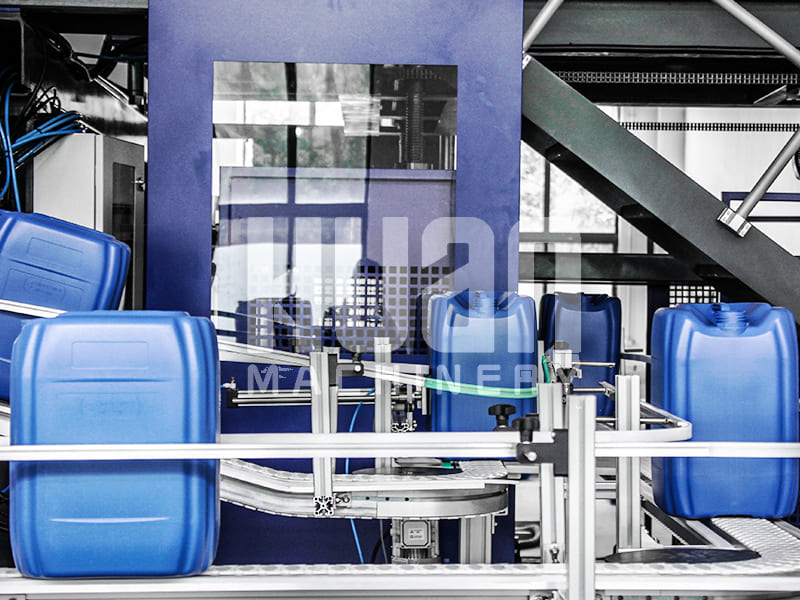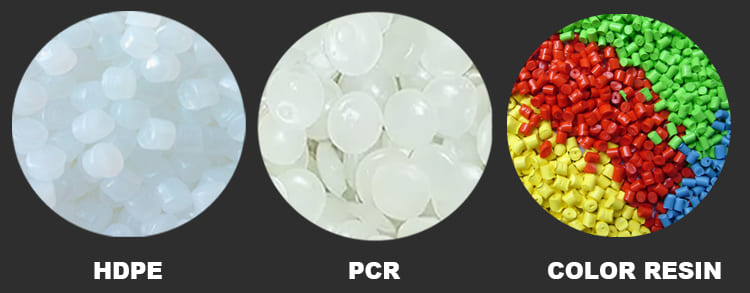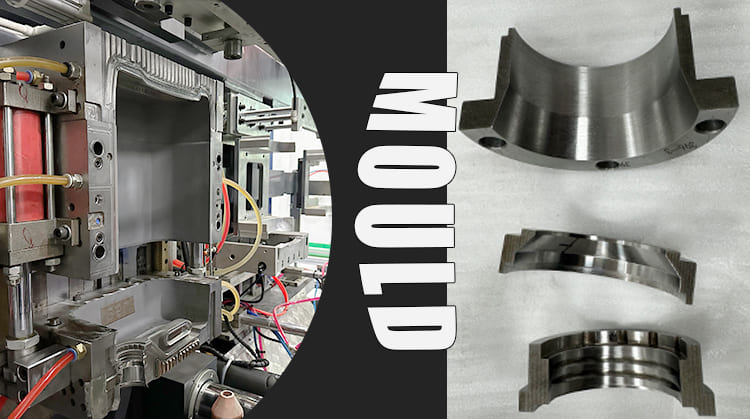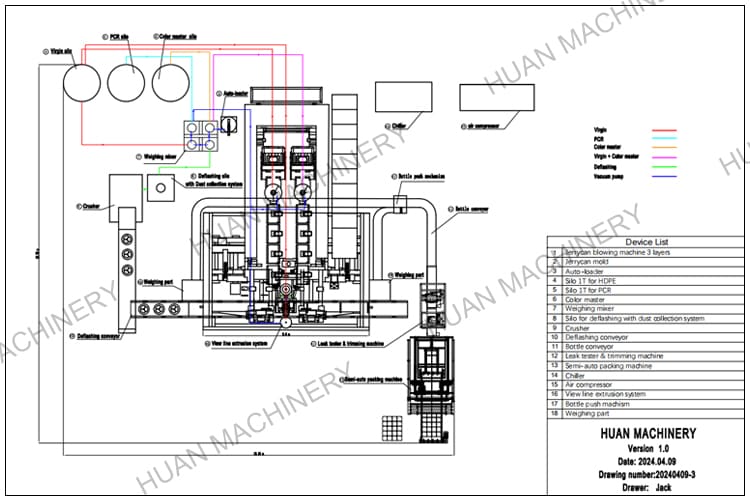
In the field of modern industrial production, the storage and transportation of materials (especially chemical raw materials) are key components of the supply chain. Stackable plastic jerry cans, with different capacity options such as 5L 20L 25L, are easy to stack and handle and have become a staple in various industries. With the advancement of technology, the 25L jerry can blow molding machine can continue to innovate and meet the market's demand for efficient manufacturing processes.
How to produce 25L jerry can?
The 25L jerry can machine exemplifies modern industrial automation, streamlining production from raw material prep to final inspection for efficient, eco-friendly storage solutions.
Raw material for 25L jerry can machine
25L jerry can bottle blowing machine adopts high density polyethylene (HDPE) as the main raw material, which has excellent chemical resistance, impact strength and recyclability, making it an ideal choice for the production of jerrycan.
When it comes to the production of 25L jerry can blow molding machines in China, the most commonly used grade of High-Density Polyethylene (HDPE) is the 50100.This specific grade of HDPE is favored for its good balance of tensile strength, environmental stress cracking resistance and ease of processing.
HDPE 50100 PHYSICAL PROPERTIES
| Item | Test Conditions | Value | Unit | Test Method |
| Physical properties |
| Melt Index (MFR) | 190℃/2.16kg | 0.06 | g/10 min | ASTM D1238 |
| Density |
| 0.948 | g/cm³ | ASTM D1505 |
| Mechanical behavior |
| Tensile yield strength | Vertical: | 530 | kg/cm² | ASTM D882 |
| Tensile yield strength | Horizontal: | 480 | kg/cm² | ASTM D882 |
| Drop weight impact |
| 100 | g | ASTM D1709 |
| Elongation at break | Horizontal: | 580 | % | ASTM D882 |
| Elongation at break | Vertical: | 470 | % | ASTM D882 |
| Elmendorf tear strength | Vertical | 30 | g | ASTM D1922 |
| Elmendorf tear strength | Horizontal | 100 | g | ASTM D1922 |
In the production of 25L jerry can blow molding machine, in addition to high-density polyethylene (HDPE), masterbatch and post-consumer recycled (PCR) materials are also used.

Our most commonly used masterbatches are white, blue, and black, and different colors of masterbatches can also be added according to your needs.
Protecting the world's environment is the responsibility of each of us, and the addition of PCR materials is particularly beneficial. Because it meets environmental sustainability goals by reducing carbon emissions and promoting the use of recycled components, it contributes to a more environmentally friendly manufacturing process and a lower environmental footprint.
Therefore, we can choose a multi-layer 25L jerry can blow molding machine, 2-layer, 3-layer, and produce multi-layer jerry cans by proportional loading through a proportional feeder.
Blow Molding Machine for 25L jerry Can
In the previous article, we introduced TOP 10 25L jerry can machine.
25L jerry can blow molding machine is a machine that controls the entire production process through PLC. The heater heats and fully melts the plastic particles, and then continuously extrude the embryos. In cooperation with the mold and corresponding auxiliary machines, qualified stacking barrels are produced. The machine can adjust parameters according to different production needs to produce stacking barrels of different specifications.

25L jerry can machine key components include:
- Heating system: ensures that the plastic raw materials are melted evenly.
- Extruder: used to form the parison.
- Mold: has a specific shape and is used to form the final product.
- Inflation system: includes an air compressor and a distribution system for delivering air to the inside of the parison.
- Cooling system: ensures that the plastic product is cooled and solidified quickly.
- Control system: PLC is usually used for automated control to ensure the accuracy and repeatability of the production process.
Mold for 25L jerry can production
The mold is custom-designed to accommodate the specific dimensions and shape of a 25L jerry can, ensuring that the final product meets the required specifications.Molds of different materials also have a certain impact on the final molding of jerry can, so the mold design can not be careless.

Design points about jerry can mold
1. Head and Base Material: For the head and base of the mold, 2316 stainless steel is recommended due to its heat resistance and durability.
2. Cooling System Design: The mold should incorporate a cooling water channel and a shaped water trench design to ensure efficient and uniform cooling of the plastic during the molding process.
3. Middle Section Material: For the middle section, magnesium alloy 7075 is suggested for its strength-to-weight ratio and good thermal conductivity, which aids in cooling.
4. Ejection System: Guide pins and bushings are recommended to be made from a high-quality material, such as those from Pan Qi, to ensure smooth operation and durability.
5. Cylinder for Ejector: Compact cylinders from Taiwan are suggested for the ejector mechanism, likely due to their reliability and compact design.
6. Post-Machining Heat Treatment: After rough machining, the 2316 stainless steel should undergo stress-relieving heat treatment to eliminate machining stresses, prevent deformation, and increase hardness for a durable cutting edge.
7. Machining Precision: The machining process should ensure the flatness and parallelism of the mold surfaces. The width of the cutting edge should be appropriate to allow for even contact and cutting between the mold halves, reducing the likelihood of burrs.
8. Aluminum Alternative: If magnesium alloy is used for the head and base, the cutting edge should be inlaid with pre-hardened stainless steel 1.2083H to maintain durability.
9. Preference for Stainless Steel: There is a preference for using solid stainless steel for the head and base due to higher mold life expectancy. Using aluminum for the mold body with inlaid cutting edges may lead to potential issues with hardness and long-term deformation, which could affect the quality of the edge finishing.
10. Quality Assurance: The design should ensure that the mold components are robust enough to withstand the rigors of high-volume production without compromising the quality of the final product.
This detailed approach to mold design and material selection is crucial for achieving high-quality, consistent production of jerry cans, while also considering the longevity and maintenance of the mold itself.
25L jerry can machine automatic line
After the 25L jerry can is blow-molded, each jerry can is trimmed, cooled, leak-tested, weighed and stacked through a seamless automated downstream auxiliary production line, thereby achieving full production line automation, reducing labor, lowering costs and improving output efficiency.
Post cooling of the 25L jerry cans is efficiently managed through a dual-cooling approach: a dedicated secondary cooling station on the machine itself, which may utilize integrated water or air cooling systems, works in tandem with the conveyor belt cooling system, where fans are strategically placed on the conveyor to uniformly cool the cans as they move away from the molding area, ensuring optimal temperature reduction for both the molds and the cans.
Leak Testing: The leak testing process is highly accurate, capable of detecting holes as small as 0.2mm. This ensures that all jerrycans are leak-proof and suitable for their intended use.
Weighing: The jerry can machine produces cans with a high degree of weight consistency, with minimal variance. This uniformity is crucial for quality assurance and compliance with product specifications.
Stacking: Post quality checks, the cans are automatically stacked, preparing them for further packaging or storage.Stacking can be automatically using robotic arms that pick up cans from the conveyor belt and stack them efficiently. This automation reduces labor and increases the speed of the process.
Visual Inspection: The use of eight cameras for visual inspection ensures a comprehensive check of the can's mouth, body, and bottom from all angles. The inspection checks for even wall thickness, smooth mold lines, and absence of blemishes such as black spots.
Packaging:
- Strapping: Cans can be bundled together using straps for compact packaging.
- Bagging Packing Machine: Alternatively, cans can be packed into polypropylene (PP) bags using a bagging machine, which then facilitates easy storage and handling.
The implementation of automated jerry can production lines has greatly improved the efficiency of stacked jerry can production, reducing reliance on manual labor and associated costs. This is a key factor for manufacturers to meet the high demand for these jerry cans in the market.

According to the customer's product requirements, factory site area, degree of automation and other aspects, we can design a jerry can production line solution for the customer free of charge.


















